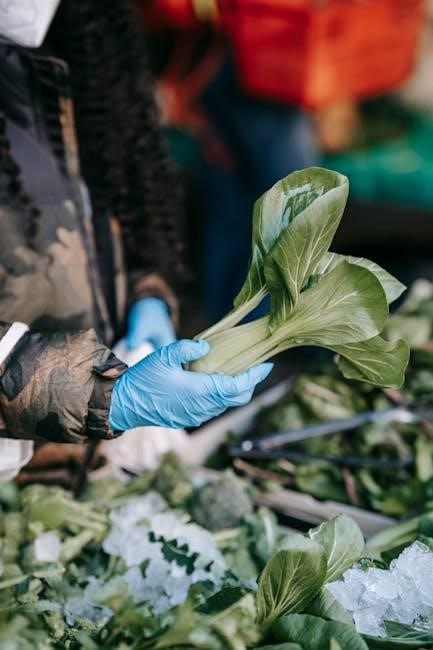This PDF guide provides essential resources for understanding food safety practices, covering key topics like foodborne illnesses, HACCP, and proper food handling. It includes multiple-choice questions and answers to help prepare for certification exams, ensuring a comprehensive understanding of food safety principles and regulations.

Overview of Food Safety Level 2 Training
Food Safety Level 2 Training is designed for individuals handling food in catering, manufacturing, or retail environments. This course covers essential principles to ensure safe food practices, focusing on preventing foodborne illnesses, maintaining personal hygiene, and understanding food safety legislation; Participants learn about key topics such as temperature control, proper food storage, and avoiding cross-contamination. The training also introduces the HACCP system and its role in managing food safety risks. By completing this course, individuals gain the knowledge and skills necessary to contribute to a safe food environment. The training is supported by resources like multiple-choice questions and practice tests, helping learners assess their understanding and prepare for certification.
Importance of Food Safety Certification
Food Safety Certification is crucial for ensuring compliance with legal requirements and maintaining high food safety standards. It demonstrates a commitment to protecting consumer health and preventing foodborne illnesses. Certification provides individuals with the necessary knowledge and skills to handle food safely, reducing risks in the workplace. Employers benefit by meeting regulatory obligations and enhancing their business reputation. Consumers gain confidence in the safety and quality of the food they consume. Additionally, certification promotes continuous learning and adaptation to evolving food safety practices. The Level 2 Food Safety Certification is particularly valuable for those in catering, manufacturing, and retail, as it ensures they are equipped to manage food safety effectively. This certification is a key asset for anyone involved in food handling.
Key Topics Covered in Level 2 Food Safety PDF
The Level 2 Food Safety PDF covers essential topics to ensure a thorough understanding of food safety practices. It includes detailed information on foodborne illnesses, their causes, and prevention methods. Personal hygiene practices, such as handwashing and protective clothing, are emphasized to minimize contamination risks. The PDF also explores food safety legislation and regulations, highlighting the roles of regulatory bodies in enforcing standards; Key areas like safe food handling, storage, and preparation techniques are discussed, with a focus on temperature control and cross-contamination prevention. Additionally, the document introduces HACCP principles and their application in food safety management. Practical multiple-choice questions and answers are provided to aid exam preparation and reinforce learning outcomes. This comprehensive resource is designed to equip individuals with the knowledge and skills needed to maintain high food safety standards in various settings. By addressing these critical areas, the PDF serves as an invaluable tool for food handlers seeking certification. The structured content ensures that learners gain a well-rounded understanding of food safety, enabling them to apply best practices effectively. Overall, the Level 2 Food Safety PDF is a complete guide for anyone involved in food preparation and service, ensuring compliance with legal requirements and promoting a safe food environment.

Foodborne Illnesses and Prevention
Foodborne illnesses are often caused by bacteria, viruses, or parasites. Prevention involves proper food handling, cooking, and storage. Understanding these is crucial for food safety certification.
Common Types of Foodborne Illnesses
Foodborne illnesses are caused by consuming contaminated food. Common types include Salmonella, E. coli, Listeria, and Campylobacter infections. These pathogens can lead to symptoms like diarrhea, vomiting, and fever. Salmonella is often linked to poultry and eggs, while E. coli is associated with undercooked beef and contaminated produce. Listeria can affect dairy products and ready-to-eat foods, posing risks to vulnerable groups. Campylobacter is frequently found in raw or undercooked chicken. Understanding these pathogens is crucial for preventing foodborne diseases and ensuring safe food handling practices. This knowledge is essential for food safety certification and protecting public health.
How to Prevent Foodborne Illnesses
Preventing foodborne illnesses requires adherence to safe food handling practices. Proper handwashing, separating raw and ready-to-eat foods, and cooking to the correct temperatures are essential. Regularly cleaning and sanitizing utensils and surfaces reduces contamination risks. Storing food at appropriate temperatures, below 5°C or above 60°C, inhibits bacterial growth. Avoiding cross-contamination by using separate cutting boards and plates for raw meats, poultry, and seafood is crucial. Consuming perishable foods promptly and not leaving them at room temperature for extended periods also minimizes risks. Following these steps significantly reduces the likelihood of foodborne illnesses and ensures a safer food environment.
Symptoms and Risk Factors
Foodborne illnesses often present with symptoms such as nausea, vomiting, diarrhea, and abdominal cramps, typically within hours to days after consumption. Severity varies, ranging from mild discomfort to life-threatening conditions. Vulnerable groups, including the elderly, young children, pregnant women, and individuals with weakened immune systems, are at higher risk of severe complications. These groups may experience prolonged illness, dehydration, or even organ failure. Understanding these symptoms and risk factors is crucial for early detection and prevention, ensuring timely medical intervention and reducing the likelihood of severe outcomes. Recognizing these signs helps in implementing appropriate food safety measures to protect both individuals and communities from foodborne hazards.

Personal Hygiene and Food Safety
Personal hygiene is critical in food safety, involving handwashing, clean uniforms, and protective equipment. It prevents contamination and ensures a safe food handling environment.
Best Practices for Personal Hygiene in Food Handling
Proper personal hygiene is essential for maintaining food safety. This includes washing hands thoroughly with soap and warm water before handling food, after using the restroom, and after touching raw ingredients. Food handlers should avoid wearing jewelry, as it can harbor bacteria; Uniforms and protective clothing, such as gloves and hairnets, should be clean and worn correctly to prevent contamination. Additionally, food handlers must be free from illnesses that could spread through food. Regular health checks and reporting any symptoms of illness are critical. Keeping nails clean and short, avoiding strong perfumes, and ensuring uniforms are laundered regularly also contribute to a hygienic food handling environment. These practices minimize the risk of cross-contamination and ensure food safety standards are met.
The Role of Handwashing in Food Safety
Handwashing is a critical practice in food safety, significantly reducing the risk of foodborne illnesses. It should be done with soap and warm water for at least 20 seconds, especially before handling food, after using the restroom, and after touching raw ingredients. Proper handwashing removes harmful pathogens and prevents cross-contamination. Food handlers should avoid wearing gloves as a substitute for handwashing, as gloves can also harbor bacteria if not changed frequently. Additionally, hands should be washed after touching surfaces, equipment, or utensils that may have come into contact with contaminated food. Neglecting proper handwashing can lead to the spread of harmful bacteria, making it a cornerstone of food safety protocols in any food handling environment.
Protective Clothing and Equipment
Protective clothing and equipment are essential in maintaining food safety standards. This includes items like hairnets, gloves, aprons, and closed-toe shoes, which prevent contamination from personal clothing and bodily elements. Gloves should be used when handling raw or ready-to-eat foods to minimize direct contact and reduce the risk of transferring pathogens. However, gloves must be changed frequently to avoid cross-contamination. Properly wearing protective gear ensures a clean environment and protects both food handlers and consumers from potential hazards. Regular inspection of protective equipment is necessary to maintain its effectiveness and integrity in the food handling process.
Food Safety Legislation and Regulations
Food safety legislation ensures compliance with standards to protect public health. Regulatory bodies enforce laws, monitor practices, and penalize non-compliance, promoting a safe food supply chain globally.
Key Food Safety Laws and Regulations
Food safety laws and regulations are designed to ensure the production, handling, and distribution of safe food products. Key legislation includes the Food Safety Act, which outlines standards for food businesses, and the HACCP (Hazard Analysis Critical Control Point) system, which identifies and controls hazards. Regulations such as the Food Hygiene (England) Regulations enforce specific practices, like proper temperature controls and hygiene standards. These laws are enforced by regulatory bodies, which conduct inspections and audits to ensure compliance. Adhering to these regulations is crucial for protecting consumer health and preventing foodborne illnesses. Understanding these laws is essential for food handlers and businesses to maintain a safe food environment.
roles of Regulatory Bodies in Food Safety
Roles of Regulatory Bodies in Food Safety
Regulatory bodies play a crucial role in ensuring food safety by enforcing laws and standards. They conduct regular inspections of food establishments to monitor compliance with hygiene and safety regulations. These bodies also audits food businesses to identify potential risks and implement corrective actions. Additionally, they provide guidance and training to food handlers and businesses on proper food safety practices. Regulatory bodies investigate foodborne illness outbreaks to determine causes and prevent future occurrences. Their oversight ensures that food products are safe for consumption, protecting public health and maintaining consumer trust in the food supply chain. Their efforts are vital for upholding high food safety standards globally.
Consequences of Non-Compliance
Non-compliance with food safety regulations can lead to severe consequences, including legal penalties, fines, and closure of food establishments. Businesses may face reputational damage, losing customer trust and revenue. Foodborne illnesses linked to non-compliance can result in lawsuits and financial liabilities. Regulatory bodies may impose stricter oversight or revoke licenses. Additionally, non-compliance can harm public health, leading to outbreaks of foodborne illnesses. Employees may also face disciplinary actions or termination for failing to adhere to safety protocols. Ensuring compliance is critical to avoid these negative outcomes and maintain a safe food environment for consumers. The consequences underscore the importance of adhering to food safety laws and standards.

Safe Food Handling and Preparation
Proper food handling and preparation techniques are crucial to ensure food safety. This includes safe storage, temperature control, and avoiding cross-contamination to reduce foodborne illness risks.
Temperature Control in Food Handling
Temperature control is a critical aspect of food safety, ensuring that food is stored, cooked, and served at safe temperatures to prevent bacterial growth. According to food safety guidelines, perishable foods must be kept below 5°C or above 60°C to inhibit the growth of harmful bacteria. During cooking, meats should reach an internal temperature of at least 75°C to ensure food safety. Additionally, when reheating food, it must reach a minimum of 75°C throughout to eliminate any potential pathogens that may have developed during storage. Proper temperature control measures help maintain food quality and prevent foodborne illnesses. Regular monitoring of temperatures is essential in food handling environments to uphold safety standards and comply with food safety regulations.
Proper Food Storage Techniques
Proper food storage is essential to maintain food safety and quality. Foods should be stored in sealed, airtight containers to prevent contamination and spoilage. Raw and ready-to-eat foods must be stored separately to avoid cross-contamination. Labeling containers with the date of storage helps ensure that older items are consumed first, following the “First In, First Out” principle. Perishable items, such as dairy and meats, should be stored at appropriate refrigerated temperatures, while non-perishables can be kept in cool, dry places. Proper storage techniques also include keeping food off the floor and away from pests. Regularly cleaning storage areas and checking for expired or spoiled items further enhances food safety. These practices help reduce the risk of foodborne illnesses and maintain the overall quality of stored foods.
Avoiding Cross-Contamination
Avoiding cross-contamination is a critical aspect of food safety. It involves preventing the transfer of harmful bacteria and other contaminants from one surface, utensil, or food item to another. This can be achieved by using separate cutting boards and utensils for raw and ready-to-eat foods. Regularly cleaning and sanitizing all equipment and surfaces reduces the risk of contamination. Hands should be washed thoroughly before handling food and after touching raw ingredients. Additionally, storing raw and cooked foods in separate containers and at appropriate temperatures prevents cross-contamination. By implementing these practices, food handlers can significantly reduce the risk of foodborne illnesses and ensure a safe food environment.

HACCP and Food Safety Management
HACCP (Hazard Analysis Critical Control Point) is a systematic approach to identifying and controlling food safety hazards, ensuring a safe food supply chain.
HACCP (Hazard Analysis Critical Control Point) is a systematic, preventive approach to food safety that identifies, evaluates, and controls hazards in the food production process. It ensures that food is safe for consumption by addressing biological, chemical, and physical hazards at every stage, from raw material selection to final product delivery. HACCP is widely recognized as a global standard for food safety management and is essential for businesses involved in food production, processing, and service. By implementing HACCP, organizations can reduce risks, prevent contamination, and maintain high food safety standards, ultimately protecting consumer health and building trust in their products;
Principles of HACCP
HACCP is built on seven core principles designed to ensure food safety through a structured approach. First, conduct a hazard analysis to identify potential biological, chemical, or physical hazards. Second, identify Critical Control Points (CCPs) where these hazards can be controlled. Third, establish critical limits for each CCP, such as temperature or pH levels, to ensure safety. Fourth, monitor CCPs continuously to maintain control. Fifth, implement corrective actions when monitoring indicates a deviation from critical limits. Sixth, maintain detailed records of the HACCP system, including monitoring data and corrective actions. Finally, verify the system regularly to ensure its effectiveness in preventing hazards. These principles provide a robust framework for managing food safety risks.
Implementing HACCP in Food Safety
Implementing HACCP involves developing and maintaining a structured food safety management system. Start by assembling a HACCP team to conduct a hazard analysis and identify Critical Control Points (CCPs) in the food process. Establish critical limits for each CCP, such as temperature, pH, or moisture levels, to prevent hazards. Implement monitoring procedures to ensure CCPs remain within safe limits. Develop corrective actions for when deviations occur and maintain detailed records of all monitoring activities and adjustments. Regular verification, including audits and reviews, ensures the system’s effectiveness. Proper training for staff is essential to uphold HACCP standards. By systematically managing risks, HACCP helps ensure the production of safe, high-quality food products, fostering compliance with regulations and enhancing consumer trust.

Food Safety Training and Certification
Food safety training enhances knowledge and compliance, ensuring safe food handling practices. Certification validates understanding of regulations and standards, benefiting both individuals and organizations in the food industry.
Benefits of Food Safety Training
Food safety training offers numerous benefits, including enhanced knowledge of safe food handling practices and compliance with legal requirements. It equips individuals with the skills to identify and mitigate risks, ensuring a safer food environment. Training also boosts employee confidence and responsibility, fostering a culture of safety within organizations. By reducing the likelihood of foodborne illnesses and contamination, it protects public health and minimizes potential legal and financial repercussions for businesses. Additionally, certification demonstrates a commitment to high standards, enhancing organizational reputation and customer trust. Regular training updates ensure ongoing awareness of evolving food safety regulations and best practices, making it a vital investment for the food industry.
How to Obtain Level 2 Food Safety Certification
To obtain Level 2 Food Safety Certification, individuals must complete an approved training course and pass a multiple-choice exam. Courses are available online or in-person, covering essential food safety topics like hazards, hygiene, and legal requirements. Upon completion, participants receive a certificate valid for a specified period, typically several years. Renewal requires repeating the training and exam to stay updated on the latest regulations and practices. This certification is recognized as a standard for food handlers, ensuring compliance with food safety laws and demonstrating a commitment to safe food practices.
Renewal and Updating Certification
Renewal of Level 2 Food Safety Certification is necessary to maintain compliance with updated regulations and industry standards. Typically, certification remains valid for three to five years, after which a refresher course and exam are required. This ensures that food handlers stay informed about new food safety practices and legal changes. The renewal process involves completing an approved training program and passing an assessment. Many providers offer online renewal courses for convenience. Keeping certification up-to-date is crucial for continued employment in food-related roles and demonstrates a commitment to food safety. Employers often require proof of current certification to ensure workplace compliance with health and safety standards.
Multiple-Choice Questions and Answers
This section provides a variety of multiple-choice questions covering key food safety topics, along with correct answers to help users test their knowledge and prepare for exams effectively.
Sample Questions on Foodborne Illnesses
Test your knowledge with these sample questions on foodborne illnesses, designed to help you understand and prevent food safety hazards.
- What is the most common type of foodborne illness caused by bacteria?
- Symptoms include diarrhea, vomiting, and stomach cramps.
- Prevention involves proper cooking and storage of food.
- Which foodborne pathogen is often linked to undercooked poultry?
- It can cause severe illness, especially in vulnerable groups.
- Thorough cooking is the best prevention method.
These questions help identify key risks and preventive measures, aiding in effective exam preparation and improving food safety understanding.
Practice Questions on Food Handling and Preparation
Enhance your understanding of food handling and preparation with these practice questions, designed to test your knowledge of safe food practices.
- What is the safe minimum internal temperature for cooking chicken?
- Answers should include 75°C (167°F).
- Explain the importance of using a food thermometer.
- How should cooked and raw foods be stored to prevent cross-contamination?
- Discuss proper storage techniques and labeling.
- Highlight the role of separate containers.

These questions cover critical areas like temperature control, food storage, and cross-contamination prevention, helping you prepare for your Level 2 Food Safety certification and ensuring safe food handling practices.

Mock Exam Questions for Level 2 Food Safety
Prepare for your Level 2 Food Safety exam with these mock questions, designed to simulate real exam conditions and cover essential topics.
- Identify the primary cause of foodborne illness.
- Answers should focus on improper food handling and storage.
- Explain the role of personal hygiene.
- What are the key steps in the food safety management system HACCP?
- Discuss hazard identification, risk assessment, and control measures.
- Highlight the importance of monitoring and documentation.
These mock exam questions ensure comprehensive preparation, helping you understand and apply food safety principles effectively.
This PDF serves as a valuable resource, summarizing key food safety concepts and providing practical guidance for ensuring safe food handling practices and continuous learning.
Food safety level 2 questions and answers PDF covers essential concepts to ensure safe food handling, including understanding foodborne illnesses, personal hygiene practices, and legal requirements. It emphasizes the importance of proper food storage, temperature control, and preventing cross-contamination. The guide also highlights the role of HACCP in identifying and controlling food hazards. By mastering these concepts, individuals can effectively protect consumers from foodborne diseases and maintain compliance with food safety regulations. These principles are critical for anyone involved in food preparation or handling, ensuring a safe and healthy food environment.

The Importance of Continuous Learning in Food Safety
Continuous learning is crucial in food safety to stay updated with evolving regulations, emerging risks, and best practices. The food industry is dynamic, with new challenges and technologies frequently arising. Ongoing education ensures food handlers remain informed about the latest safety protocols and legal requirements. Resources like food safety level 2 questions and answers PDF provide accessible tools for reinforcing knowledge and adapting to changes. Regular updates help prevent foodborne illnesses, maintain compliance, and enhance overall food safety standards. By fostering a culture of continuous learning, individuals and organizations can uphold consumer trust and ensure a safer food environment for everyone.